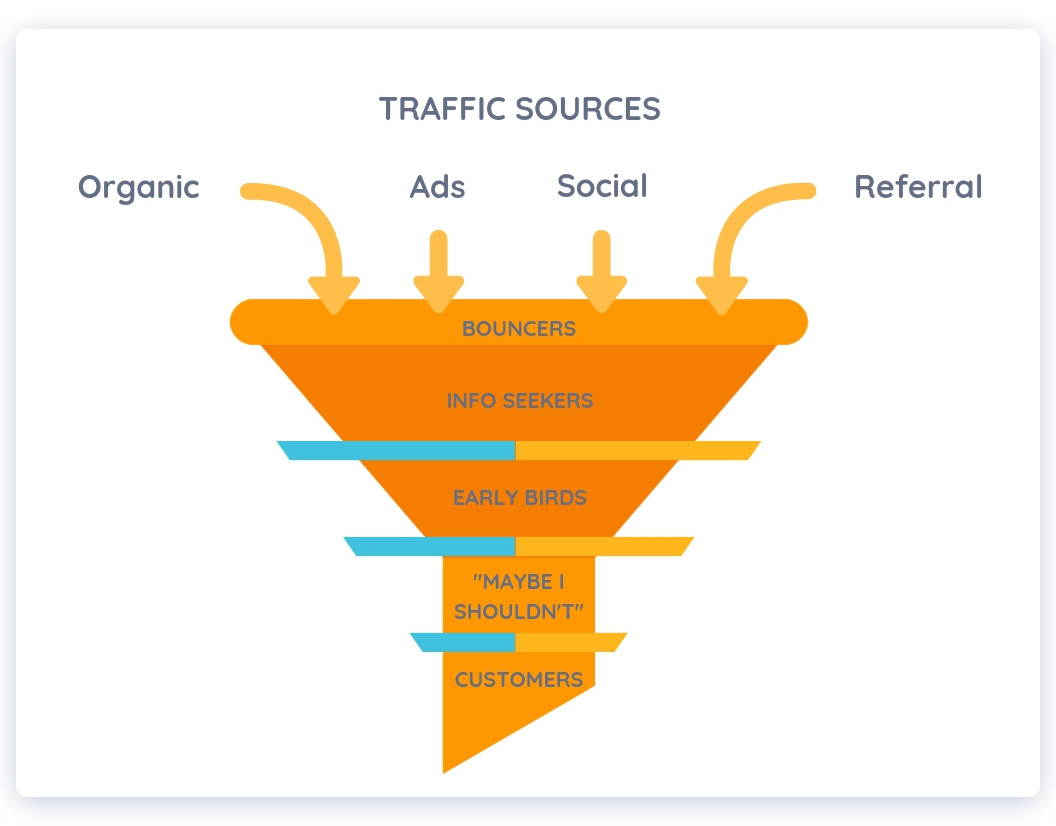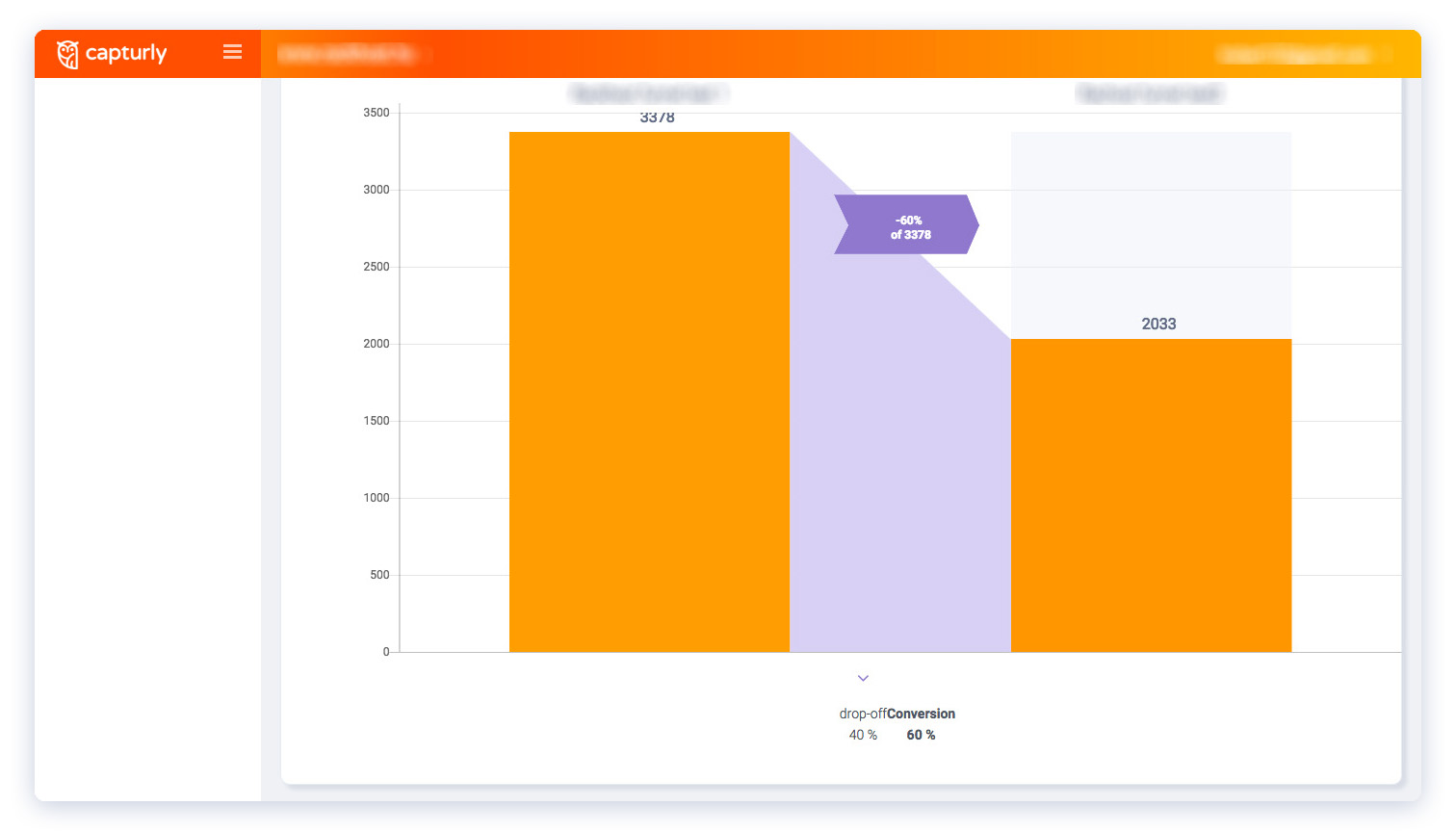What does the term ‘conversion’ stand for? What does CRO mean? If you have not met this concept during Google Ads ad (pun intended), you can still easily figure out the meaning: an event counts as a conversion when a visitor of your website does something desirable. I could also say that he/she is converting from a visitor to a (potential) customer. Learn why conversion rate is important.
Let me demonstrate it. For webshops, it is usually purchased, but conversion can be a newsletter subscription or, for example, registration as well. What counts exactly as a conversion can be defined when determining the goals of a website.
Do you want a short wrap up? Check these slides.
In the rest of the article, you can learn about CRO meaning and CRO definition.
Table of Contents
Setting conversion goals
When setting conversion goals, you can ask the following questions:
- Has the purchase been made?
- Did you provide the requested information?
- Did you finish shopping or simply left?
- Are you subscribed to your newsletter?
- Did you call me for an offer or did you contact me?
To increase your earnings and optimize your sub-targets, you need to calculate your conversion rate after the measurement. There are plenty of ways to achieve a conversion. Conversion tracking and conversion rate optimization are techniques used to measure conversion efficiency. The so-called conversion rate shows how many visitors have been converted from a given number of visitors to customers, that is, reaching the ultimate goal. You can calculate the conversion rate as follows:
CR = Number of goals achieved / number of visits x 100
Let’s say that your website (home) is popular and 32 428 sessions have been made by users arriving in the given period. The number of completed goals (transactions) was 364. In this case, the conversion rate for e-commerce is 1.12%.
For example, you can measure conversions:
- destination URL
- shopping cart value (average spending per customer)
- time spent on your site
- pages / visits
- events
Needless to say, conversion rate optimization is an indispensable process so you can determine how your online business is performing. Keeping an eye on your conversion rates can reveal not only strengths but also weaknesses.
A tiny increase in conversions from 1% to 2% can result a huge growth in sales and revenue.
Increasing and improving the latter is the most important task. Nobody will buy from you if you use too complex product lists, long product descriptions, complex designs. What is even worse is that your customers will not keep their negative opinions to themselves.
What are the elements of the conversion process?
CRO meaning
It is complex to define CRO definition. When it comes to conversions or website conversion rate optimization, most people think that it’s about a user who visits a webshop, looks for a product, selects it, then orders it. Quite frankly, this is the case, but it is not that simple.
For this process to be flawless, several background processes need to work as well, such as search engine optimization (SEO), social media presence, search engine compliance (AdWords), website load speed, and of course website design and user experience (UX). All of these play their own role as part of the conversion, so broadly speaking, optimizing them is part of the conversion rate optimization process.
Micro- and Macro-Conversions
To understand the vast amount of data in your business, you can distinguish between micro-contracts and macro conversions – in terms of the importance of your goal – from conversions. What you can consider being macro and which micro-conversion depends on the main purpose of the website and the goals we have set for each stage of the process of becoming a buyer.
A micro-conversion is the sub-goal that the user reaches to achieve the ultimate goal (macro-conversion).
These can be the following:
- subscription to newsletters
- the time spent on your blog page is at least 3 minutes
- video viewing
- banner engagement
You should consider the macro-conversion as the main purpose of your website, your application, that is why you should create it.
This may be:
- transaction,
- request,
- subscription,
- achievement,
- click on ads,
- or for non-profit organizations.
During Conversion Optimization, you should plan and continuously measure which goal you want to increase at each level of the AARRR model: micro and/or macro conversions.
Measuring conversions- Why Conversion Rate is Important
As the first step in conversion optimization, it is imperative to set the measurability of conversions. Without proper planning, it is impossible to complete the process and increase the revenue, as there is no data you could improve. This is why you need Goals for your CRO strategy. You need to pick them wisely to be measurable. You can set and measure goals in Capturly, Google Analytics, Google Adwords, or Facebook Business Manager depending on your preference.
Conversion Rate Problems- Why Conversion Rate is Low
Many factors can alter the results of the conversion rate calculation. Before I can talk diving deeper into the actual calculation and analysis of the conversion rate take a look at the following list:
- lack of internal IP address filtering – it’s important to filter out every IP that comes from inside the company. Your marketers, developers can generate a lot of fake traffic
- calculation errors – if you look at Google Analytics, the way it calculates the conversion rate is the following:
- Incorrect metric Counting (For example, as a default, Google Analytics calculates the conversion rate as the following: Conversion Rate = Conversion Rate / Total Sessions, Conversion Counts / Number of Total Users (Conversions / Users) For example, in a given month, one user visited the site 100 times and once purchased a product, then the conversion rate is only 1%, while in fact, 100% is the correct data because the user has bought it).
- the wrong definition of goals
- high shopping cart abandonment rate – this is a problem that is often overlooked
- incorrectly set goals (The goals set up in Google Analytics are inadequate. For example, it’s a goal to view the Bid Request page when there was no actual bid request that would be the actual goal of the webpage)
- you’ll have to take all conversions into account instead of a specific conversion (For example, you could consider newsletter subscriptions as conversions, while you’re just looking for purchases).
If any of the above-mentioned occurs that’s why conversion rate is low. Here’s a guide for more tips on how to improve conversion rate.
The Conversion Funnel
Without a doubt, the conversion funnel is the cornerstone of the conversion rate optimization process. It is a detailed representation of the customer journey process of one’s website or application. The name “funnel” comes from the popular visual representation of the conversion process.

The actual funnel that you can find in website analytics tools looks something different, however, the way it works is the same. What we call conversion, is a multi-level process. Let’s call these stages checkpoints for the sake of easy understanding. When a visitor goes past a certain checkpoint he/she gets one step closer to becoming your customer.
Conversion funnels can be scary as they depend on multiple factors, for example on the type of business you are running, your target audience, the goals you set, etc. Bad user experience can kill your conversions. If you sell online courses with a certification, a goal can be the competition of the course. On one end you have the visitors/potential students who visit your website, and on the other end of the funnel, you have certified personnel.
If 1000 students enrolled and 900 of them managed to pass the final test, you have a 90% conversion rate. In case you run an e-commerce business, that sells hiking accessories, a successful payment on your checkout page can be a goal. If you have 10000 visitors per month and 100 of them make an actual purchase, then your conversion rate is 10%. In between the entry and the endpoints you can define as many stages as you desire, however, it is not recommended to overcomplicate your conversion funnel.
For a webshop a typical structure should look something like this:
Visitors arrive -> check the product -> add to list/cart -> proceed to checkout and pay.
The more visitors your website attracts to the top of your funnel, the better your chances are.

What is CRO?-Conversion Rate Optimization Process
The CRO process is intended to increase the conversion rate for website visitors, meaning that more than the same number of people implement the conversion action. To do so, most of the time you need to modify your website or just change your landing page. Optimization must be a never-ending task. It is always possible to be better and better, so this process must be started from the beginning. That is why conversion rate optimization is important.
50% of businesses state that conversion rate optimization is a crucial part of their digital marketing strategy.
If you wish to increase your conversion rate, the first step is to determine your goal and then collect and analyze the data. Based on these, set up hypotheses, then different variants that you implement. Then test and analyze the results and start over the whole process.
Let’s see how this happens:
- You can start by analyzing the data (Analytics and, if necessary, a session replay system). Make sure the goals you set are realistic and analyze the performance of your conversion funnel. Check for leaks in the conversion funnel. By doing so, the chances of newer problems occurring are common but do not look at them as something bad.
- When you have gathered enough information, it’s time to take action with the help of your conversion rate optimization tool. Apply the changes based on the measured results.
- This is followed by the phase of testing. During the tests, keep track of how the new settings are performing, ie how your conversion rate changes.
Here is a ready-to-go checklist that can help you on your journey:
- Clarify the conversion goals – if you want more downloads, trial subscriptions, purchases make sure that you are communicating these in form of CTAs, pop-ups, etc.
- Review the navigation of your site so that it does not allow customers to think too long and search for hours to complete a single task. This is actually one of the cornerstones of increasing the conversion rate of your website. Many people make the most mistakes here.
- Explain the security of transactions because this is a very important aspect, especially for an e-commerce website.
- Enable customers to publish customer reviews. This is a good reference for your potential customers and it can dramatically speed up the shopping process.
- Have a landing page. It can not only provide more traffic, but it can also be great for testing purposes, as it’s easy to change and measure since you do not need to rebuild a complete website.
- Perform A/B and multiple tests whenever you feel like it.
Regardless of the ever-changing conversion rate optimization trends, the core process stays the same. Let’s take a closer look at each step of the process:
STEP 1: Definition of a Goal- What Conversion Rate is Good
This is the first and most important step in the process. Without clear, understandable, and measurable goals you won’t know what to do in the next step. You cannot evaluate whether the change you made has actually contributed to our goal or is just worsening on.
You can distinguish the following goal categories:
- Instant goals – such as button clicks, pageviews
- Campaign goals – can focus on lead generation or purchase
- Long-term goals – net revenue, a desired average shopping cart value, or leads
Depending on the page of your website (home page, product page, landing page, etc.), your goals can – and probably will – be different. For example during Black Friday events a landing page motivates visitors to purchase. On a pricing page, the page view is usually the goal. In some cases, like when dealing with content marketing on a blog, lead generation can be a (long-term) goal.
STEP 2: Collecting Data- Why Measure Conversion Rate
Collecting data is important because everyone has a vision of what works and what doesn’t in their industry, but these are just assumptions that can easily be based on mistakes. That’s why you need to collect information and data. Where do you get data from? With the help of website analytics, you can find plenty of information about site performance, campaigns, conversions, shopping cart values, and more. It is important to pay close attention to the proper collection of these data.
STEP 3: Data Analysis

The data collected in the previous step should also be analyzed for you to be able to draw the right conclusions from them. This analysis often requires a lot of time and expertise. It is useful to figure out which data is meaningful.
Ask questions from yourself like:
- What is my conversion rate and what is it right for me?
- What is a good customer retention rate for me?
- How and why does it lower my conversion rate?
- What is a low conversion rate?
STEP 4: Set Up Hypotheses
Hypotheses are about what changes you need to make to improve your website to improve its conversion rate. The hypothesis should include:
- The intention you wish to test later
- The way it affects your visitors
- The expected result
So the sentence should look like this:
I think that if I do … [1] …. what happens is … [2]…., then … [3] …. happens.
It is important to formulate the expected output very accurately so that you can then evaluate its fulfillment.
STEP 5: Making Variations

Based on the first hypothesis you can create variations that will be tested later. It’s important to keep in mind that testing takes time. If a relatively small number of visitors arrive daily on the website, testing will take a long time, so it is worth testing just a few things at a time to have enough data to see a significant difference between the performance of the original and the new variant.
Generally, a test takes about 7 to 14 days and can only begin testing itself. However, in reality, there may be problems and technical obstacles that can postpone the project. After that, you just have to wait for enough data to come together.
Now let’s look at some examples of what changes companies are actually trying to test on their own website to improve the conversion rate:
- Change the text and or color of a button
- Implementing Call-to-Actions (CTAs) into long-form content
- Changing the location of testimonials and references
- Reducing the number of form fields, and the input methods as well
- Reducing or modifying the amount of text on a single page
- Optimizing the content in the above-the-fold section
- Simplifying the look and feel of the website
- Adding “eye-candy” elements to the website (badges, profile pictures, etc.)
Implementing and Running Tests
Without implementing a tested technology, you can not run A/B tests. There are several solutions. For example, Google Optimize, or Unbounce which can be used relatively easily, but like everything else, learning and experience are the keys to long-term success. Each test must be run until it has a statistically significant result, otherwise, you can’t be sure that one variation was better than the other. The results can depend on more than one factor.
For example, they can depend on how many visitors there are on the website, how many people do the desired action, or how many tests are run at one time. It is recommended that you run only one test at a time, as it is the easiest way to determine that the change was actually due to the change in the given factor.
It’s also important to know when to stop a test. There are some cases where simply a bug slips into the test (there is a technical problem). In this case, you have to stop the test and look for the error. But it may also be seen at the beginning that the tested variation is much worse than the original. It is also worthwhile to end the testing of that variation before that time.
To find out if you want to run a test, let us ask yourselves the following questions:
- Does the page I want to test affect long-term success? If so, then you should test it.
- Is there anything else on this page that is of more importance? If so, then you should first test it.
- Can I draw some conclusions from the results of the test, which can be useful for the rest of the site? If so, you might want to run this first.
- Can a test be carried out within a predictable time frame? If not, then you should not run the test.
Analysis of results
In this section, we draw lessons from the test to see what happened.
The most important tasks are:
- Look at growths or losses.
- Create a report about it. (what, when, how, visual results, numerical results, what you learned from the test)
- Save the data for later.
- Share data with people for whom this is important.
During the analysis, ask yourself the following questions:
- Has the performance increased, decreased, or stagnated?
- If I encountered the opposite of the hypothesis, why could that be?
- Do I want to test this again? Was there any unusual occurrence that could have affected the test result?
- How can I use the results for future tests?
You will use these results to plan your next test!
As mentioned earlier, testing and optimization must be continuous and always be part of the complex marketing strategy. Each test helps your website to convert more efficiently.
Grouping Conversion Optimization Tools
I like to split CRO tools into two main groups. The first group includes the so-called “actual” website optimization tools. The second group includes survey tools.
As you’ve read above, CRO tools provide website/webshop owners with solutions that can increase their conversion rate, but we need to understand how the conversion funnel is built and which points may have a problem that needs to be solved. This leads us to the first group of Conversion Rate Optimizer tools. These were designed to test the current status of your website. For example, VWO or Usability Hub’s Five Second Test.
Moreover, the first group includes web analytics tools that can lead to an idea of where to optimize the page (eg. Google Analytics, Capturly). After you have measured the status of your website and have made changes with the help of a web analytics tool, you may want to measure the effectiveness of your activities. Here’s the part where the A/B testing software (eg Google Optimize, Unbounce) plays an important role to help you get back to the design table based on actual test results. Now you can further refine your conversion rate optimization process by turning your page into something irresistible to your users.
There are also survey tools. With their help you can directly collect data from your visitors by asking them – for example, why they do not convert to customers on a particular website if the other site brings the expected results – eg (Survey Monkey, i-Perceptions).
If you think this will end the list of website optimization tools then you’re wrong. Some tools help you technically optimize your website – upload speed, browser caching, image optimization, etc. – (eg. Google Page Speed Insights, GTmetrix).
Wrapping Up:
Now you know why conversion rate optimization is important, why it is crucial to measure conversion rate, what conversion rate is good and why conversion rate is low.
Conversion rate optimization is not your typical process that has a start and an end. It’s all about continuous measurement and testing. The massive data generated through online campaigns means nothing, without measuring and interpreting it. It is out of the question, and therefore, the most important conversion optimization tool is continuous measurement and then ongoing testing. We’ve already mentioned Google Analytics, which is known by many of the tools to measure, but besides Google’s search engine analytics software, we have several analytical tools based on different methodologies to maximize your number of conversions (and ultimately your profit).
For additional information, here is a great conversion rate optimization guide from an expert.
Don't forget, sharing is caring! :)


20 Comments
Alexpaul
2020-07-26 at 12:12Thanks for sharing your knowledge with us. I come through this blog by chance and found great and useful contents in it and I will definitely be updated through your blog. keep sharing the information.
frankie
2021-06-17 at 16:13nice
warren
2022-06-10 at 16:00Helping set up my colleagues website, I stumbled upon your article and found it really helpful!
Cezanne Zadzisai
2023-01-20 at 11:24We appreciate you sharing your knowledge with us. By coincidence, I came on this page and found some very fantastic and helpful content. I will most certainly keep up with your blog. Continue to spread the word.
eladó cégek
2024-01-13 at 14:12This is an insightful post. Thanks for sharing it. I am looking forward to reading more of these.